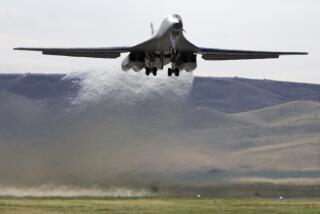Study Reports $6 Billion in Excess B-1B Costs
- Share via
WASHINGTON — The cost of deploying a fleet of 100 B-1B bombers will exceed initial estimates by more than $6 billion, according to a congressional study released Sunday by the House Armed Services Committee.
The additional money is primarily for a variety of items that are not part of the formal B-1B program but which are required to field the planes, said the panel’s chairman, Rep. Les Aspin (D-Wis.).
The items include flight simulators and some spare parts for the planes, Aspin said. In the past, those have been included in the budget programs of other planes.
$27.9-Billion Cost
The additional costs of $6.2 billion detailed by the General Accounting Office, a congressional watchdog agency, would bring the total B-1B program cost to $27.9 billion.
In response, the Air Force issued a statement saying: “The cost conclusions contained in the news release are misleading. The B-1B costs do not exceed expectations. The cost to acquire the weapons system, as well as support costs to deploy and operate the system, have been programmed and included in all of our budget requests to Congress.”
The report is the latest round in a long-running dispute between the Air Force and congressional critics, chiefly the House panel, who have argued that the plane is both more expensive, and less capable, than the service claims.
B-52’s Replacement
The B-1B was originally intended to replace the aging B-52 as the main bomber in the nation’s three-legged nuclear triad, which also includes land-based and submarine-launched missiles.
More to Read
Get the L.A. Times Politics newsletter
Deeply reported insights into legislation, politics and policy from Sacramento, Washington and beyond. In your inbox twice per week.
You may occasionally receive promotional content from the Los Angeles Times.








